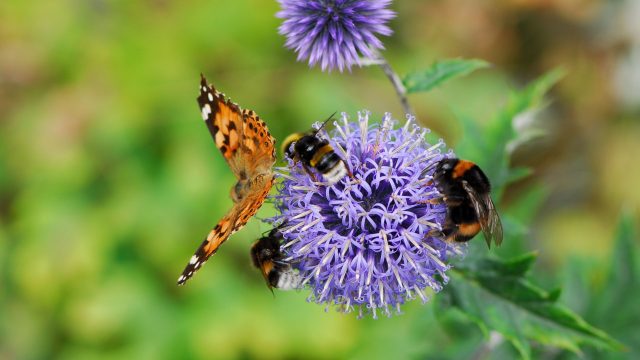27
Apr
Nevada Assembly Votes Unanimously To Protect Pollinators, Recognizes Deficiencies of EPA Regulations

(Beyond Pesticides, April 27, 2023) The Nevada Assembly, by unanimous vote, took the state one step closer to banning the use of neonicotinoid insecticides used on plants, with a waiver for commercial agricultural purposes. Despite dramatic declines in bee populations linked to neonicotinoid pesticides and other toxic pesticides, the U.S. Environmental Protection (EPA) and state regulatory authorities have for the most part ignored beekeepers and the independent scientific literature by allowing widespread toxic pesticide use—forcing elected officials to take protective action. Portions of the bill would take effect upon passage or no later than January 1, 2024. Maine and New Jersey have adopted similar legislation.
The failure to adequately regulate pesticides under federal law, the Federal Insecticide, Fungicide, and Rodenticide Act (FIFRA), and EPA inaction is viewed by environmentalists as the shocking disregard for the importance of biodiversity to sustaining life. The inadequate restriction of pesticides and slower than necessary transition to organic land management practices are viewed as major contributors to the “insect apocalypse.” The legislation (A.B. 162), led by Assemblywoman Michelle Gorelow and a group of nine other Assemblymembers, illustrates a growing trend of local and state legislative bodies asserting their authority to protect against health, biodiversity, and climate crises, linked to petrochemical pesticides and fertilizers, that are escalating out-of-control to devastating levels—with the U.S. Congress and federal agencies standing silent.
“We applaud the Nevada Assembly’s initiative to protect pollinators and urge elected officials nationwide to see the pending biodiversity collapse as reason for broader action to eliminate petrochemical pesticides and fertilizers with organic systems that are effective and cost competitive,” said Jay Feldman, executive director of Beyond Pesticides.
A systematic review of insect population studies worldwide in Biological Conservation magazine (2019) reports on “the dreadful state of insect biodiversity in the world, as almost half of the species are rapidly declining and a third are being threatened with extinction.” The study concludes with the dire prediction that insects as a whole will go extinct in the next few decades if patterns of pesticide use and other factors continue. Many systemic pesticides, like neonicotinoids are taken up by the vascular system of the plant and expressed through pollen, nectar, and guttation droplets, causing indiscriminate poisoning and death to pollinating and foraging insects, including bees, butterflies, and birds. The chemicals also move through soil, killing terrestrial and aquatic organisms.
The complexity of pesticide hazards is captured in a statement by biology professor Matthew Forister, PhD, University of Nevada (Reno), who told the Natural Resources Nevada Assembly Committee: “[T]he extreme and prolonged droughts of recent decades are reducing the densities of beneficial insects in . . .open lands. This new reality elevates the importance of all decisions that we make about managed lands, and chief among these decisions is the use of pesticides.”
As is typical, pesticides often cause a mixture of environmental and public health effects. According to Drew Toher, community resource and policy director, Beyond Pesticides, “Emerging data shows neonicotinoids can act as hormone disruptors, increasing the risk of breast cancer; they can readily transfer from mother to fetus through the placenta, increasing risk of birth defects; they are associated with liver damage, and neurological impacts like memory loss.”
The Toiyabe Chapter of the Sierra Club said, “The good news is that there are many safe alternatives to using neonicotinoid pesticides. If we switch to these safer methods, we could save the pollinators, other animals, and improve human health.”
The New York State Assembly passed a similar bill (A03226), the Birds and Bees Protection Act. The Act bans neonicotinoid use on outdoor ornamental plants and turf, with a general exemption for agriculture except for treated seed. The bill, opposed by the New York Farm Bureau, contains a ban on seeds treated with neonicotinoids, but includes an “emergency” override by the State Commissioner of Agriculture, based on a written determination that (i) a valid environmental emergency exists; (ii) the pesticide would be effective in addressing the environmental emergency; and (iii) no other, less harmful pesticide or pest management practice would be effective in addressing the environmental emergency. The bill would immediately ban chlothianidin or dinotefuran, leaving the most widely used neonicotinoid imidachloprid, as well as thiamethoxam or acetamiprid, on the market until July 1, 2025.
All unattributed positions and opinions in this piece are those of Beyond Pesticides.
Sources: A.B. 162; Beyond Pesticides’ Nevada testimony; statement of Dr. Forister; Statement of Toiyabe Chapter of the Sierra Cub; Birds and Bees Protection Act..










